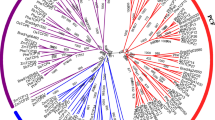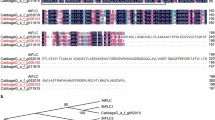Abstract
TEOSINTE BRANCHED1/ CYCLOIDEA/PROLIFERATING CELL FACTORS (TCP) are a group of plant-specific genes that encode transcription factors and play essential roles in plant growth and development. Of these genes, Arabidopsis TCP5 (AtTCP5), TCP13 (AtTCP13), and TCP17 (AtTCP17) regulate flowering time, one of the important factors of plant development. Controlling flowering time of Pak-choi (Brassica rapa ssp. chinensis) is a method of improving plant growth conditions, as vegetative tissues such as leaves are not produced after floral transition. To investigate functional conservation in three Pak-choi TCP genes homologous to AtTCP5, AtTCP13, and AtTCP17 in the regulation of flowering time, we isolated BcTCP5, BcTCP13, and BcTCP17 from a Pak-choi cultivar. The deduced amino acid sequences of the selected TCP genes were 65–82% identical to the three aforementioned AtTCP proteins. The expression levels of BcTCP5, BcTCP13, and BcTCP17 were spatially different and were unaffected by vernalization treatment. The three BcTCP proteins also localized in the nucleus, and interacted with Arabidopsis FLOWERING LOCUS D (AtFD) and PHTOCHROME INTERACTING FACTOR4 (AtPIF4). Overexpression of BcTCP17 in Arabidopsis plants led to an early flowering phenotype by up-regulating endogenous Arabidopsis FOWERING LOCUS T (AtFT) and APETALA1 (AtAP1) expression, suggesting that BcTCP17 regulates flowering time in Arabidopsis. Our results indicated that the three BcTCPs isolated from Pak-choi plants are the equivalents of corresponding AtTCPs, and that BcTCP17 may be a candidate to be used in the regulation of flowering time in Pak-choi plants utilizing the clustered regulatory interspaced short palindromic repeats (CRISPR)/CRISPR-associated protein (Cas) system.






Similar content being viewed by others
Change history
19 September 2022
A Correction to this paper has been published: https://doi.org/10.1007/s11816-022-00792-8
References
Citerne HL, Luo D, Pennington RT, Coen E, Cronk QC (2003) A phylogenomic investigation of CYCLOIDEA-like TCP genes in the leguminosae. Plant Physiol 131:1042–1053
Cubas P, Lauter N, Doebley J, Coen E (1999) The TCP domain: a motif found in proteins regulating plant growth and development. Plant J 18:215–222
Faivre-Rampant O, Bryan GJ, Roberts AG, Milbourne D, Viola R, Taylor MA (2004) Regulated expression of a novel TCP domain transcription factor indicates an involvement in the control of meristem activation processes in Solanum tuberosum. J Exp Bot 55:951–953
Gubitz T, Caldwell A, Hudson A (2003) Rapid molecular evolution of CYCLOIDEA-like genes in Antirrhinum and its relatives. Mol Biol Evol 20:1537–1544
Han X, Yu H, Yuan R, Yang Y, An F, Qin G (2019) Arabidopsis transcription factor TCP5 controls plant thermomorphogenesis by positively regulating PIF4 activity. iScience 15:611–622
Heim MA, Jakoby M, Werber M, Martin C, Weisshaar B, Bailey PC (2003) The basic helix-loop-helix transcription factor family in plants: a genome-wide study of protein structure and functional diversity. Mol Biol Evol 20:735–747
Hong CP, Kim J, Lee J, Yoo SI, Bae W, Geem KR, Yu J, Jang I, Jo IH, Cho H, Shim D, Ryu H (2021) Gibberellin signaling promotes the secondary growth of storage roots in Panax ginseng. Int J Mol Sci 22:8694
Howarth DG, Donoghue MJ (2006) Phylogenetic analysis of the “ECE” (CYC/TB1) clade reveals duplications predating the core eudicots. Proc Natl Acad Sci USA 103:9101–9106
Huang F, Liu T, Hou X (2018a) Isolation and functional characterization of a floral repressor, BcMAF1, From Pak-choi (Brassica rapa ssp. chinensis). Front Plant Sci 9:290
Huang F, Liu T, Wang J, Hou X (2018b) Isolation and functional characterization of a floral repressor, BcFLC2, from Pak-choi (Brassica rapa ssp. chinensis). Planta 248:423–435
Huang F, Liu T, Tang J, Duan W, Hou X (2019) BcMAF2 activates BcTEM1 and represses flowering in Pak-choi (Brassica rapa ssp. chinensis). Plant Mol Biol 100:19–32
Hwang YH, Kim SK, Lee KC, Chung YS, Lee JH, Kim JK (2016) Functional conservation of rice OsNF-YB/YC and Arabidopsis AtNF-YB/YC proteins in the regulation of flowering time. Plant Cell Rep 35:857–865
Jeong HH (2022) Genome editing of BcFT and BcTCP5/13/17 in Pak-choi (Brassica rapa ssp. chinensis) using CRISPR/Cas9 technology. Dessertation, Jeonbuk National University
Kim YC, Kang Y, Yang EY, Cho MC, Schafleitner R, Lee JH, Jang S (2021) Applications and major achievements of genome editing in vegetable crops: a review. Front Plant Sci 12:688980
Koornneef M, Alonso-Blanco C, Peeters AJ, Soppe W (1998) Genetic control of flowering time in Arabidopsis. Annu Rev Plant Physiol Plant Mol Biol 49:345–370
Kosugi S, Ohashi Y (2002) DNA binding and dimerization specificity and potential targets for the TCP protein family. Plant J 30:337–348
Lee JH, Ryu HS, Chung KS, Pose D, Kim S, Schmid M, Ahn JH (2013) Regulation of temperature-responsive flowering by MADS-box transcription factor repressors. Science 342:628–632
Lee JH, Kim YC, Jung Y, Han JH, Zhang C, Yun CW, Lee S (2019) The overexpression of cucumber (Cucumis sativus L.) genes that encode the branched-chain amino acid transferase modulate flowering time in Arabidopsis thaliana. Plant Cell Rep 38:25–35
Li C, Potuschak T, Colon-Carmona A, Gutierrez RA, Doerner P (2005) Arabidopsis TCP20 links regulation of growth and cell division control pathways. Proc Natl Acad Sci USA 102:12978–12983
Li D, Zhang H, Mou M, Chen Y, Xiang S, Chen L, Yu D (2019) Arabidopsis class II TCP transcription factors integrate with the FT-FD module to control flowering. Plant Physiol 181:97–111
Martin-Trillo M, Cubas P (2010) TCP genes: a family snapshot ten years later. Trends Plant Sci 15:31–39
McClung CR, Lou P, Hermand V, Kim JA (2016) The importance of ambient temperature to growth and the induction of flowering. Front Plant Sci 7:1266
Navarro C, Cruz-Oro E, Prat S (2015) Conserved function of FLOWERING LOCUS T (FT) homologues as signals for storage organ differentiation. Curr Opin Plant Biol 23:45–53
Putterill J, Laurie R, Macknight R (2004) It’s time to flower: the genetic control of flowering time. BioEssays 26:363–373
Quint M, Delker C, Franklin KA, Wigge PA, Halliday KJ, van Zanten M (2016) Molecular and genetic control of plant thermomorphogenesis. Nat Plants 2:15190
Sarvepalli K, Nath U (2011) Hyper-activation of the TCP4 transcription factor in Arabidopsis thaliana accelerates multiple aspects of plant maturation. Plant J 67:595–607
Tian C, Wan P, Sun S, Li J, Chen M (2004) Genome-wide analysis of the GRAS gene family in rice and Arabidopsis. Plant Mol Biol 54:519–532
Wang C, Cui HM, Huang TH, Liu TK, Hou XL, Li Y (2016) Identification and validation of reference genes for RT-qPCR analysis in non-heading Chinese cabbage flowers. Front Plant Sci 7:811
Wei W, Hu Y, Cui MY, Han YT, Gao K, Feng JY (2016) Identification and transcript analysis of the TCP transcription factors in the diploid woodland strawberry Fragaria vesca. Front Plant Sci 7:1937
Weigel DGJ (2002) Arabidopsis: a laboratory mannual. Cold Spring Harbor Laboratory Press, New York
Wigge PA (2013) Ambient temperature signalling in plants. Curr Opin Plant Biol 16:661–666
Zhou Y, Zhang D, An J, Yin H, Fang S, Chu J, Zhao Y, Li J (2018) TCP transcription factors regulate shade avoidance via directly mediating the expression of both phytochrome interacting factors and auxin biosynthetic genes. Plant Physiol 176:1850–1861
Acknowledgements
We thank Dr. H. Ryu for kindly providing research material (a RFP-tagged AtARR2 marker). We also thank Ms. Y.Y. Choi, Center for University-wide Research Facilities (CURF) at Jeonbuk National University, for confocal microscopic observations. Financial support for this work was provided by a grant (PJ01532503 to J.H. Lee) from the Rural Development Administration (RDA), Republic of Korea. This work was also supported in part by a grant (2020R1I1A1A01072914 to Y.-C. Kim) from the Basic Science Research Program of the National Research Foundation (NRF), Republic of Korea. The authors would like to thank the Writing Center at Jeonbuk National University for its skilled proofreading service.
Author information
Authors and Affiliations
Corresponding authors
Additional information
Publisher's Note
Springer Nature remains neutral with regard to jurisdictional claims in published maps and institutional affiliations.
Supplementary Information
Below is the link to the electronic supplementary material.
Rights and permissions
Springer Nature or its licensor holds exclusive rights to this article under a publishing agreement with the author(s) or other rightsholder(s); author self-archiving of the accepted manuscript version of this article is solely governed by the terms of such publishing agreement and applicable law.
About this article
Cite this article
Jeong, H.H., Kim, YC. & Lee, J.H. Identification and functional characterization of TEOSINTE BRANCHED 1/CYCLOIDEA/PCF (TCP) transcription factor genes in Pak-choi (Brassica rapa ssp. chinensis). Plant Biotechnol Rep 16, 309–316 (2022). https://doi.org/10.1007/s11816-022-00760-2
Received:
Revised:
Accepted:
Published:
Issue Date:
DOI: https://doi.org/10.1007/s11816-022-00760-2




